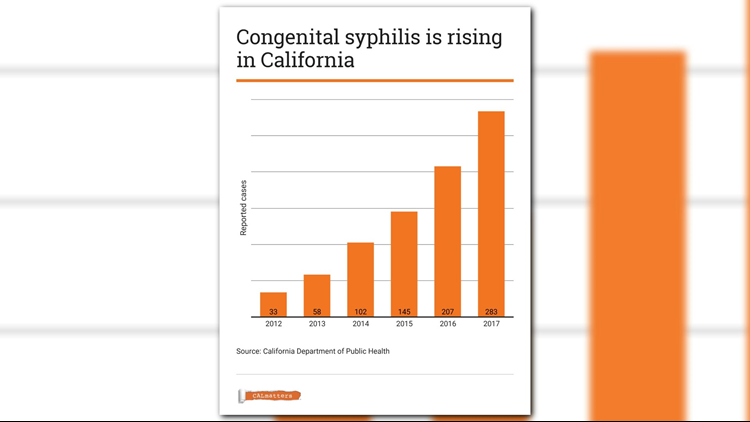Jeffrey Klausner has seen the damage congenital syphilis can do to newborns, and it makes him a little sick.
“It’s one of the horrible outcomes,” said Klausner, an infectious disease professor at UCLA’s medical school. “You have devastation of the newborn.”
It’s not just the neurological harm the illness causes, or the infant deaths or stillborn deliveries, he said, but the fact that it’s all preventable—with a single antibiotic shot.
About two decades ago, congenital syphilis was all but eradicated in California, the most populous state. But in the past six years, the number of cases has jumped from 33 to 283—almost a tenfold increase. It’s the highest number of cases in any state and accounts for the third-highest rate per live birth, behind Louisiana and Nevada.
California owns the dubious distinction of having about a third of the nation’s congenital syphilis cases. Thirty infected babies were stillborn in the state last year, the most on record since 1995.
“It is shameful,” Klausner said. “These are statistics we see among the poorest countries in the world.”
Many countries have virtually eradicated the illness by making sure pregnant women are screened and treated for syphilis. The World Health Organization set a benchmark—50 cases per 100,000 people—that it expects 80 percent of the world’s countries to meet by the end of the decade. California does not hit that standard.
“This is a failure of the public health system,” Klausner said.
Congenital syphilis is a debilitating disease, passing to unborn babies through the placental wall. Symptoms at birth can include meningitis, anemia, enlarged liver and spleen, pneumonia and mental retardation.
Why is the dramatic spike in congenital syphilis occurring in California, the sixth-largest economy in the world, with a dramatically expanded health system? The answer is complicated.
“We see some parts of the state where it’s more prevalent,” said Heidi Bauer, chief of STD (sexually transmitted disease) Control for the California Department of Public Health.
She’s referring to the Central Valley, particularly Kern County, where a high number of cases have been recorded. That area is strongly affected, she said, by “high rates of poverty, homelessness and substance abuse,” Bauer said. “It’s a variety of things.”
California law requires syphilis screening for all pregnant women at their first prenatal visit. But in more than half of the state’s congenital syphilis cases, women didn’t get prenatal care until the third trimester, if at all. Almost half of the pregnant women whose babies had syphilis acknowledged using methamphetamine in the year before their diagnosis, and 13 percent said they had exchanged sex for money or drugs in the year before their diagnosis.
“In Kern County in particular, there’s lots of meth use. Lots of transactions to get drugs,” said Jennifer Wagman, a UC San Diego professor who’s researching the cause of the congenital syphilis spread.
Syphilis has been an issue in the LGBTQ community, but it barely existed in the heterosexual community, and it’s unusual to see a sexually transmitted disease cross over to heterosexual women, she said.
“We’re seeing a mixing up of partnerships in that subset” of poor female drug users in the Central Valley, Wagman said. “So we’re seeing these higher rates in these pocket communities, where there are gaps in the health-care system and gaps in access to care.”
Another contributor, she said, is that California as a whole has a higher rate of all sexually transmitted disease than most other states. Over the past five years, rates have climbed 45 percent in California, with a record number of more than 300,000 cases in 2017.
In addition, “we are seeing more women who are unstably housed, and many with substance-use problems,” Bauer said. “Many of them have had children removed from them in the past.”
Women with previous congenital-syphilis births who’ve had those children taken from them may be reluctant to get any health care at all, fearing the authorities will take the next baby, Bauer said. So some women bear more than one child with congenital syphilis.
She said the state concentrates on reaching women who have been incarcerated or those in the sex industry, because they’re at greater risk for drug use, unprotected sex and infection. The state also reaches out to substance-abuse treatment centers and providers of homelessness services, trying to get women tested for sexually transmitted diseases even before any pregnancy.
But to Klausner, that’s a band-aid approach. Other states and countries do more comprehensive screening and treatment, he said, with close local monitoring of pregnant women to make sure they are screened, provided with the test results and helped with access to treatment. That process takes manpower, and California is hamstrung by too low a budget, he said.
California’s last budget for prevention of sexually transmitted diseases was about $11 million. The state added $2 million in the current spending plan, but only for a single year.
“That’s a joke,” Klausner said. “Epidemics go up exponentially. That’s a spit in the ocean.”
Advocates had pushed for an ongoing $10-million-a-year increase.
Wagman said the state needs to fund a large-scale investigation to figure out why congenital syphilis is rising and how to fix the problem.
“Most of my work has been in sub-Saharan Africa, primarily in Uganda,” she said, “...and there is no congenital syphilis in Uganda because they’re so actively monitoring it” through testing and follow-up. But many doctors in California think of congenital syphilis as a disease that’s been eliminated, she said.
“I don’t think anyone expected this to go on the way it has,” Wagman said. “Everyone’s trying to figure out what the next steps are.”
Klausner said he can answer that one.
“It’s not a medical problem at all; it’s a public health problem,” he said. “We need surveillance, response and intervention. Syphilis is eminently controllable.
“The reality is, if you don’t make it a priority, what’s going to stop it?”
CALmatters.org is a nonprofit, nonpartisan media venture explaining California policies and politics.



